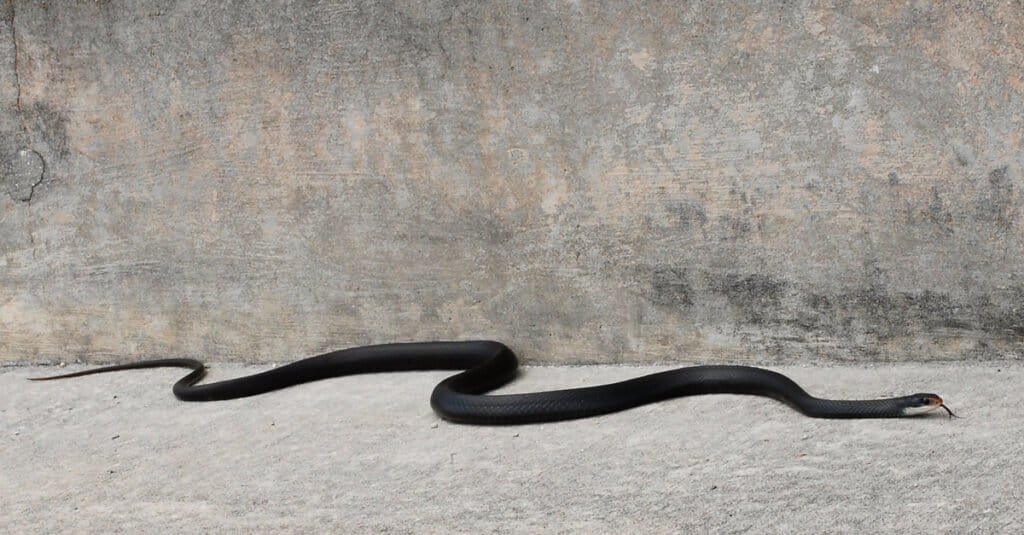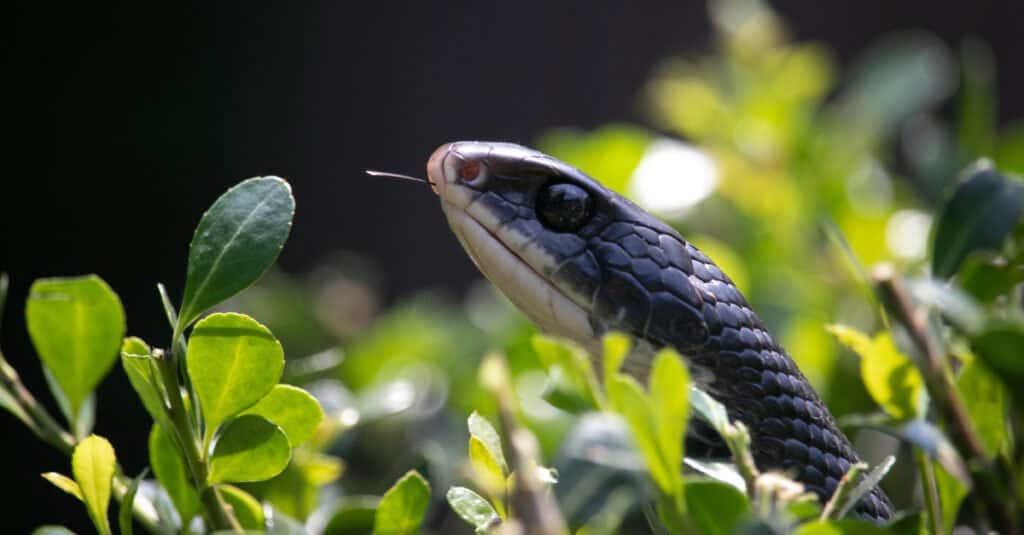Colubrid snakes are also known as typical snakes in North America, including indigo snakes and black racers. But, how do you tell the two species apart? When it comes to indigo snakes and black racers, there are important differences, as well as many similarities between the two. Both snakes are native to the United States, though one grows far larger than the other.
In this article, we’ll take a closer look at the eastern indigo snake vs black racer. By the end, we’ll know exactly how the two species differ in size, appearance, habitat, behavior, diet, and lifespan. We’ll learn about what makes these snakes similar and what sets them apart.
Read on to learn just how different eastern indigo snakes are from black racers.
Comparing Eastern Indigo Snake vs Black Racer

| Eastern Indigo Snake | Black Racer | |
| Size | 4-10 pounds; 60-84 inches long | 1-2 pounds; 20-60 inches long |
| Appearance | Entirely black to blue-black with orange markings on the chin and sides of the face. Longest native snake in the United States | All black to blue-black scales with lighter bellies and white markings on the throat. Large red eyes with round pupils |
| Location and Habitat | Southeastern United States; riparian zones, pine woods, glades, and swampy areas | Eastern United States; forests, flatlands, and shrublands |
| Behavior | Flattens head and vibrates tail when threatened. Only bites as a last resort; non-aggressive | Mimics rattlesnakes by vibrating tail when threatened; only bites when provoked |
| Lifespan | 12-21 years | 5-10 years |
Key Differences Between Eastern Indigo Snake vs Black Racer

The black racer has white coloring on the chin.
©Perry Correll/Shutterstock.com
Eastern indigo snakes are bigger and heavier than black racers. While both are mostly black, indigo snakes have orange-colored throats, while black racers have white-colored throats. Neither species are venomous, though they both mimic the dangerous species of snakes when threatened.
Let’s take a closer look at the key differences between the eastern indigo snake and black racer.
Eastern Indigo Snake vs Black Racer: Size and Weight

The indigo snake weighs more than the black racer.
©Joe Farah/Shutterstock.com
Indigo snakes are the longest snakes native to the United States; they can grow up to nine feet long. In the U.S., there are two common species of indigo snakes – Texas indigo snakes and eastern indigo snakes. Black racers are medium-sized, slender-bodied snakes, but they are around 4.5 feet long. Indigo snakes have thick bodies with narrow heads.
The biggest difference between indigo snakes and black racers comes from their weights. Black racers weigh only 1-2 pounds, while eastern indigo snakes weigh between 4-10 pounds.
Eastern Indigo Snake vs Black Racer: Location and Habitat

Black racers are commonly found in flatlands and frequent shrublands.
©Breck P. Kent/Shutterstock.com
One difference to note between eastern indigo snakes and black racers is their range: Eastern indigo snakes can be found only in the southeastern United States, in Florida, Georgia, Alabama, and Mississippi. Black racers also live in the southeastern part of the United States, but they can be found as far north as southern Maine, and far west as eastern Texas.
Eastern indigo snakes love the water; they’re commonly found in swampy areas, glades, pine woods, and riparian zones near freshwater. On the other hand, black racers tend to frequent shrublands, flatlands, forests, and the edges of urban and suburban areas.
Eastern Indigo Snake vs Black Racer: Appearance

Indigo snakes have blue-black bodies with orange-colored chins.
©Joe Farah/Shutterstock.com
In comparison, eastern indigo snakes vs black racers look very similar. They both have black to blue-black bodies with lighter bellies and narrow heads. But, eastern indigo snakes have orange-colored chins and throats, whereas black racers have white chins. In addition, eastern indigo snakes have much thicker bodies than black racers.
Their adult phase may look similar, but indigo snakes and black racers look very different when they’re babies. Juvenile eastern indigo snakes look very similar to adults; they’re black with orange throats. But black baby racers start as light brown snakes with darker brown patterning. As they age, they darken in color until they attain their true black scales.
Eastern Indigo Snake vs Black Racer: Behavior

Black racers often eat amphibians and insects.
©TjacksonVii/Shutterstock.com
The eastern indigo snake and black racer share many characteristics when it comes to behavior. They’re both active only during daylight hours. Both species lack venom and will only bite humans when threatened or provoked. Indigo snakes rear up and flatten their heads to make themselves appear larger and more dangerous. Similarly, black racers coil up and vibrate their tails like rattlesnakes to scare off predators.
Black racers eat everything from insects to fish to bird eggs. They are also known to eat amphibians, small mammals, and birds. Eastern indigo snakes are particularly known for eating other snakes, even the venomous rattlesnake.
Eastern Indigo Snake vs Black Racer: Lifespan
Black racers are believed to live an average of 5-10 years in the wild. Indigo snakes live a little longer, between 12-21 years. As babies, both species have high mortality rates due to predation by other snakes, birds, and mammals. If they make it to adulthood, they have a good chance of living a long, full life.
The photo featured at the top of this post is © Radiant Reptilia/Shutterstock.com
Discover the "Monster" Snake 5X Bigger than an Anaconda
Every day A-Z Animals sends out some of the most incredible facts in the world from our free newsletter. Want to discover the 10 most beautiful snakes in the world, a "snake island" where you're never more than 3 feet from danger, or a "monster" snake 5X larger than an anaconda? Then sign up right now and you'll start receiving our daily newsletter absolutely free.
Thank you for reading! Have some feedback for us? Contact the AZ Animals editorial team.






